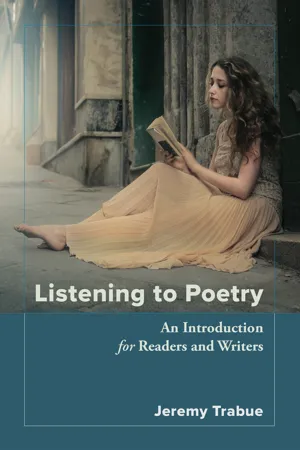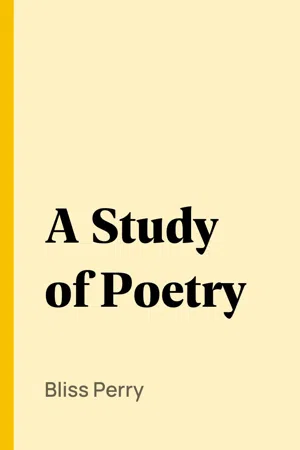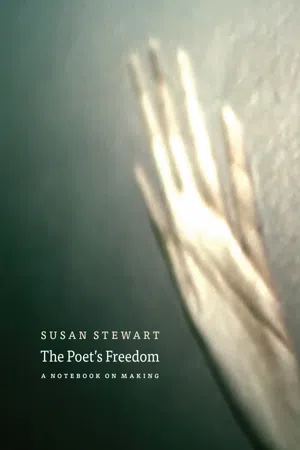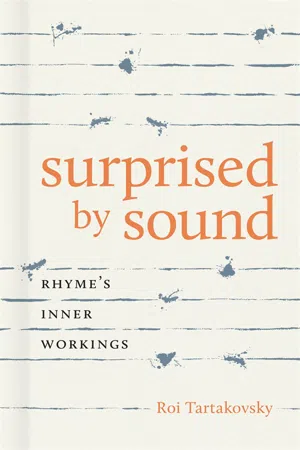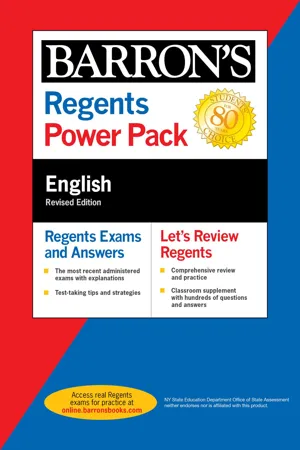Literature
Internal Rhyme
Internal rhyme is a poetic device where a word within a line of poetry rhymes with another word in the same line or within nearby lines. This technique adds musicality and rhythm to the poem, creating a sense of cohesion and unity within the verses. Internal rhyme can also draw attention to specific words or ideas, enhancing the overall impact of the poem.
Written by Perlego with AI-assistance
Related key terms
6 Key excerpts on "Internal Rhyme"
- Editors of REA(Author)
- 2012(Publication Date)
- Research & Education Association(Publisher)
The most common is the end rhyme, which has the rhyming word at the end of the line, bringing the line to a definite stop but setting up for a rhyming word in another line later on, as in “Stanzas”: home… Rome, a perfect rhyme. Internal Rhyme includes at least one rhyming word within the line, often for the purpose of speeding the rhythm or making it linger. Look at the effect of Byron’s Internal Rhymes mixed with half-rhymes: “combat… for that”; “Can/And… hanged” slowing the rhythm, making the reader dwell on the harsh long “a” sound, prolonging the sneer which almost becomes a snarl of anger. Slant rhyme, sometimes referred to as half, off, near, or approximate rhyme, often jolts a reader who expects a perfect rhyme; poets thus use such a rhyme to express disappointment or a deliberate let-down. Masculine rhyme uses one-syllable words or stresses the final syllable of polysyllabic words, giving the feeling of strength and impact. Feminine rhyme uses a rhyme of two or more syllables, the stress not falling upon the last syllable, giving a feeling of softness and lightness. One can see that these terms for rhyme were written in a less enlightened age! The terms themselves for the rhymes are less important than realizing or at least appreciating the effects of the rhymes. If the lines from “Stanzas” had been unrhymed and varying in metrical pattern, the verse would have been termed free, or to use the French term, “Vers libre,” not to be confused with blank verse, which is also unrhymed but has a strict rhythm. The Elizabethan poets Wyatt and Surrey introduced blank verse, which Shakespeare uses to such good effect in his plays, and later, Milton in the great English epic Paradise Lost. Free verse has become associated with “modern” poetry, often adding to its so-called obscurity because without rhyme and rhythm, poets often resort to complicated syntactical patterns, repeated phrases, awkward cadences, and parallelism- eBook - ePub
Listening to Poetry
An Introduction for Readers and Writers
- Jeremy Trabue(Author)
- 2019(Publication Date)
- Chemeketa Press(Publisher)
At the other extreme, there are also many people who think of nonrhyming poetry as “modern” and rhyming poetry as “traditional.” This is also inaccurate. Old English poetry did not rhyme at all, nor did much poetry in Middle English. Unrhymed verse has been part of modern English right from the beginning. Seventeenth-century poet John Milton wrote a blistering attack on rhyme in his introduction to Paradise Lost (which does not rhyme). And most early English dramatic verse is mostly written without any rhyme (though some short rhyming passages do appear in Shakespeare and other renaissance drama).The role and importance of rhyme in poetry was much debated and contested in Milton’s time, and it still is today. Unrhymed poetry is more common, but rhyming poetry is alive and well. Rhyme is not omnipotent or omnipresent. Rhyme does not define “poem.” However, it is a part of poetry, and it’s here to stay.Rhyme is one of those subjects for which the phrase “deceptively simple” was created. Most preschoolers recognize and can give examples of rhyming words. Most could easily recognize the rhymes in this list:bed / embed / said / read bay / weigh / astray / they wing / asking / unifying / testifying lady / bee / abbey / tabbyBut what exactly makes these words “rhyming”? The entire ending syllable is not exactly the same in each one because the ending syllables may start with different consonant sounds. The spelling is certainly not the same in each one. However, the ending syllable after its initial con sonant sound is the same. Notice that they don’t have to have the same number of syllables, either, as long as that final syllable sound after its initial consonant is identical.Rhyme is the repetition of the same vowel sound followed by the same consonant sound—if there is one—in the final syllable of two or more words and in close enough proximity that it creates an obvious pattern. That’s the basic definition, but there is a lot of variation just under the surface of that definition that you should be aware of.Varieties of Rhyme
Rhyme is such a rich subject that there are different varieties of rhyme.First, rhymes can be either internal or end. End rhyme occurs at the ends of lines, and is the most common.When people talk about rhyme, they usually mean end rhyme. Internal Rhyme, - eBook - ePub
- Bliss Perry(Author)
- 2005(Publication Date)
- Perlego(Publisher)
Rhyme is thus a form, an "externalizing" of rhythm. It is structural as well as decorative, or rather, it is one way of securing structure, of building verse. There are other devices, of course, for attaining symmetrical patterns, for conveying an impression of unity in variety. The "parallel" structure of Hebrew poetry, where one idea and phrase is balanced against another, "I have slain a man to my wounding— And a young man to my hurt—" or the "envelope" structure of many of the Psalms, where the initial phrase or idea is repeated at the close, after the insertion of illustrative matter, thus securing a pattern by the "return" of the main idea—the closing of the "curve"—may serve to illustrate the universality of the principle of balance and contrast and repetition in the architecture of verse. For Hebrew poetry, like the poetry of many primitive peoples, utilized the natural pleasure which the ear takes in listening for and perceiving again an already uttered sound. Rhyme is a gratification of expectation, like the repetition of a chord in music [Footnote: "Most musical compositions are written in quite obvious rhymes; and the array of familiar and classical works that have not only rhymes but distinct stanzaic arrangements exactly like those of poetry is worth remembering. Mendelssohn's 'Spring Song' and Rubinstein's 'Romance in E Flat' will occur at once as examples in which the stanzas are unmistakable." C. E. Russell, "Swinburne and Music," North American Review, November, 1907.] or of colors in a rug. It assists the mind in grasping the sense-rhythm,— the design of the piece as a whole - eBook - ePub
The Poet's Freedom
A Notebook on Making
- Susan Stewart(Author)
- 2011(Publication Date)
- University of Chicago Press(Publisher)
Poetic rhyme is a record of the living language, more particularly the poet’s living language at a moment of relation between languages and poetic practices—it is thus both more local and more universal than any given language’s storehouse of rhymes. Those third- and fourth-century Latin hymns mentioned above that work under both quantitative and qualitative systems of meter are a practice where diverging traditions meet. 35 The variable initial, internal, and terminal rhymes of Hebrew liturgical poetry in the fourth century and the free-floating rhymed strophes of early eleventh-century Iberian Arabic poetry are further examples of syncretic rhyming practices. Whereas Chaucer’s rhymes tend, like those French rhymes on which they were modeled, to be full or “perfect” for the most part, from the time of Spenser forward similar, rather than identical, sounds are used. Sidney’s Defence of Poetry suggests that rhyme is an ornament, adding a pleasing melody and harmony to a work. 36 Other writers, such as the prosodist George Saintsbury, have been concerned with rhyme as a punctuating device in rhythm. 37 Moments of intense rhyming activity seem to coincide with the meeting of dialects and languages—the melting pot of troubadour culture, the macaronic verse of medieval scholasticism, Dante’s turn between Latin and the Tuscan vernacular, Chaucer’s encounter with Romance languages, Edmund Spenser’s with Irish. We find other polyglot practices in Pushkin’s use of Turkish rhyming words in his poems of 1829 38 and the Greek, French, German and English rhymes of Ezra Pound and T. S. Eliot. The freezing and melting that typify erotic poetry in the West also seem to characterize the social life of rhymes. Rhyming fixes sounds inflexibly at the ends of lines, or freezes a local pronunciation like a fossil - eBook - ePub
Surprised by Sound
Rhyme's Inner Workings
- Roi Tartakovsky(Author)
- 2021(Publication Date)
- LSU Press(Publisher)
26 We can observe a similar maneuver if we add the last line of the previous stanza:Herself - though - fled !Another bed - a short one -Due to the rhyme, there is a likely pause after bed; the word is perceived as a sonic end, a closing of rhyme that started with fled. This sense of an ending is aided by the phrasal and rhetorical break that is represented by the subsequent dash, a hallmark of Dickinson’s poetics. And yet there is an alternative end close at hand, that of the line unit, with which this end does not coincide. The ending of rhyme is counterbalanced by the continuation of the line.In this way, rhyme is akin to punctuation, sonically punctuating the line. Internal Rhyme has a rhythmic effect on the pacing of the line: rhyme is a cue for accenting and pausing. If the second of the two rhyming partners cues for pause, it does so in this poem by joining the numerous dashes, line ends, and phrasal ends. The entire stanza becomes acutely disjointed at each step, and the poem rarely lets us go more than two or three words before forcing some kind of halt. The overall effect, quite typical of Dickinson, is that fraught admixture of high bursts of energy amid much hesitation.SPORADIC RHYME, ENDINGS, AND CLOSURES
Finally, I would like to turn to the employment of sporadic rhyme in the most strategic of places in a poem: its ending. When rhyme comes at the poem’s end, at least two endings overlap: the end of the rhyme—reached with the second of the two rhyming words—and the end of the poem. Barbara Herrnstein Smith has shown that poems tend toward “terminal modification,” a change that comes at the end of the poem to strengthen closure and break the expectation for the continuation of the same. In a consistently rhyming poem, terminal modification can be achieved with a change in the rhyme scheme. A prime example is the Shakespearean sonnet: after three quatrains in a row, one is set up to expect more quatrains, but then the poem signals its ending by switching to a couplet. The concluding couplet, Smith writes, is a terminal modification that has become “incorporated into the convention of the sonnet” (53). And the same concluding couplet can just as easily signal an ending in other contexts. A nonrhyming speech in a play, for instance, could end ceremoniously with a rhyme that would reinforce the fact that it is an ending.27 - eBook - ePub
- Carol Chaitkin(Author)
- 2021(Publication Date)
- Barrons Educational Services(Publisher)
page 81 ) create the effect of Internal Rhyme.- irony In general, a tone or figure of speech in which there is a discrep-ancy—(a striking difference or contradiction)—between what is expressed and what is meant or expected. Irony may be used to achieve a powerful effect indirectly. In satire, for example, it may be used to ridicule or criticize. Stephen Crane’s poem “Do Not Weep, Maiden, for War Is Kind” (page 88 ) is intensely ironic, both in the stanzas apparently seeking to comfort those whose lovers, fathers, and sons have died and in the contrasting stanzas of apparent celebration of the glories of war. We also speak of dramatic irony in fiction in which the reader understands more than the characters do. Ring Lardner’s short story “Haircut” is an excellent example.
- lyric A general term used to describe poems that are relatively brief and expressed in the voice of a single speaker (narrative voice). Lyric poems express a powerful emotion revealed in a significant experience or observation. (See discussion on page 78 .)
- metaphor A form of analogy. Through metaphor, a poet discovers and expresses a similarity between dissimilar things. The poet use metaphors to imaginatively find common qualities between things we would not normally or literally compare. As a figure of speech, metaphor is said to be implicit or indirect. This contrasts to simile (see page 98 ), where the comparison is expressed directly. In his final soliloquy, Macbeth uses a series of metaphors to express the meaninglessness of his own life: “Life’s but a walking shadow, a poor player . . . it is a tale told by an idiot . . . .”
- meter and rhythm Rhythm refers to the pattern of movement in a poem. As music has rhythm, so does poetry. Meter refers to specific patterns of stressed and unstressed syllables. See iambic pentameter
Index pages curate the most relevant extracts from our library of academic textbooks. They’ve been created using an in-house natural language model (NLM), each adding context and meaning to key research topics.

